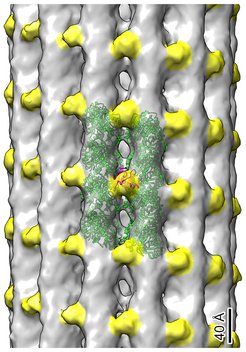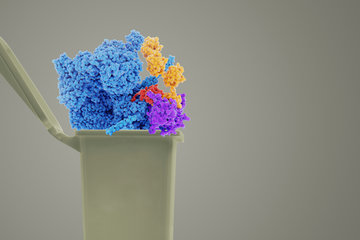A peek inside a cellular antenna
Dresden researchers discover new features of primary cilia
Cells sense their environment and send signals to other cells to function properly. The responsible “organ” to perform these functions is the cilium, an antenna-like structure protruding from most vertebrate cells. While motile cilia have been studied extensively, the three-dimensional architecture and molecular composition of non-motile cilia, also called primary cilia, are largely unexplored. The research group of Gaia Pigino at the Max Planck Institute of Molecular Cell Biology and Genetics in Dresden has now developed a method for investigating the structure of primary cilia at molecular resolution by cryo-electron tomography.

When we explore our environment, we rely on senses like hearing, seeing, tasting, or smelling. A cell senses their surroundings through cilia, antenna-like structures that protrude from most vertebrate cells. Cilia enable cells to move, to communicate, and to interpret molecular signals.
Inside a cilium is a microtubule-based cytoskeleton that is studied fairly well in motile cilia. The same is not true for primary cilia, which have long been seen as a remnant of evolution and have falsely been thought of as a simplified version of motile cilia. But unlike motile cilia, which are found on only some cell types in our bodies, most of our cells have a primary cilium. For example, olfactory sensory cilia enable us to smell, photoreceptor cilia sense light and we can see.
Given this crucial role of cilia in our bodies, their malfunctions can cause a wide range of human diseases, including retinal degeneration, polycystic kidney disease, Bardet-Biedl syndrome, or congenital heart disease. It is therefore of critical importance to better understand primary cilia. To date, there is little mechanistic understanding of how primary cilia perform their functions, and what held us back to better understand them are missing methods to inspect their structure at molecular resolution.
Structure analysis with high resolution
With this motivation in mind, research group leader Gaia Pigino and her team at the Max Planck Institute of Molecular Cell Biology and Genetics set out to explore more about the structure of primary cilia. They started to work on a method that would eventually allow them to see the molecular structure of the primary cilium in high-resolution. The challenge was to separate the cilia from the cells without destroying their many fine structural details, and then look at them under a particularly powerful electron microscope. Petra Kiesel, the technician of the research group and the person who developed the method, explains: “We combined a variation of an existing chemical method with a mechanical one, in order to isolate the cilia from kidney cells directly on the microscopy support to image them with our favorite electron microscope.”
For this, the researchers used a method called cryo-electron tomography, a special technique to image fast-frozen biological samples in a way that full 3D models of seen molecular structure can be created. With this technique, the researchers were able to observe primary cilia at such a high-resolution that individual proteins could be identified. Gonzalo Alvarez Viar, PhD student in the research group, reports: “The structures we saw are very different from the ones, we know from motile cilia. Their cytoskeleton is less organized and has a less symmetrical structure. Motile cilia are known to have a nine-fold symmetry in order to move around, but we didn’t see anything like this in primary cilia.”
Cilia contain actin filaments
But not only the structure of known components turns out to be different. Primary cilia also surprised with a number of other novelties, for example the presence of actin filaments inside those cilia. Actin Filaments are found in the cytoplasm of eukaryotic cells and form part of the cytoskeleton. “Finding filamentous actin in cilia was a huge surprise to us. It was sometimes hinted at by other experiments, but only few people really believed in it since there has never been solid evidence”, says Gaia Pigino who oversaw the study.
The findings reveal a lot of previously unknown facts and surprising differences between the well-studied motile cilia and little understood primary cilia. “Our method will pave the way for many insightful investigations of primary cilia and, in turn, allow us to better understand these important organelles in animals and humans, in health and disease”, concludes Gaia Pigino.












